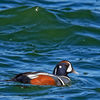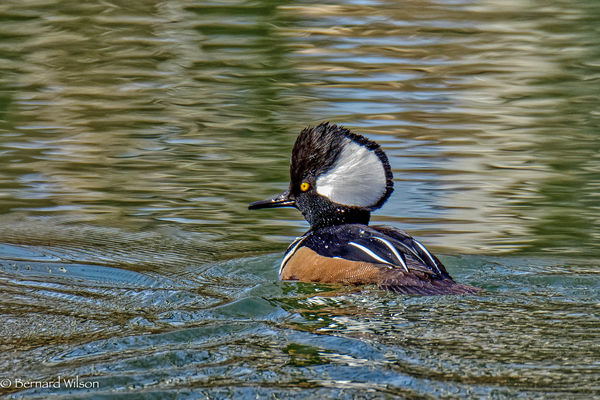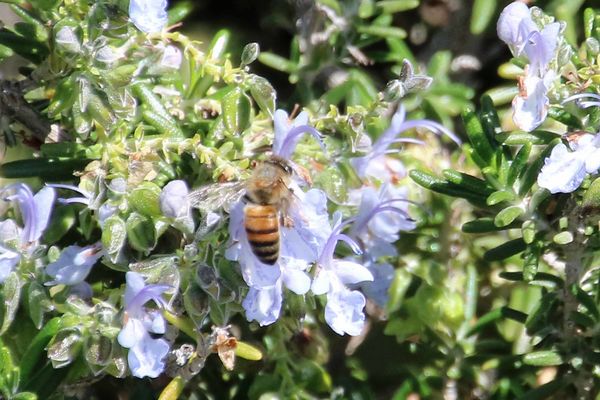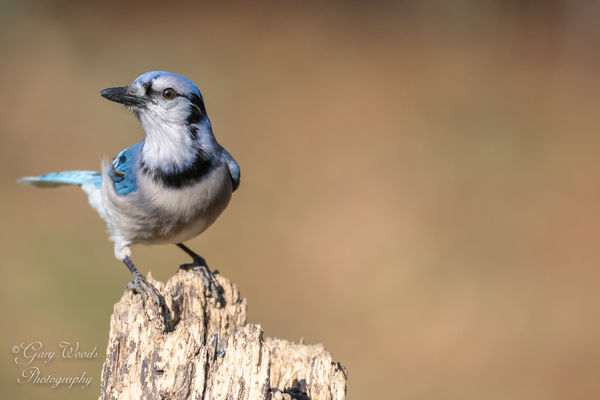How to get better details from your wildlife photos
Feb 19, 2019 13:53:04 #
I finally took time to pull up the exif. Nikon D7000 at 1/1000, f/6.3 so a shallow depth of field with a small subject in a big scene, focus was probably not on the bird. But mostly what I see is a lot of camera movement. Were you by any chance in a boat (a tripod might actually make it worse, moves with the boat) or standing and hand holding after walking and so not real steady?
As stated, it takes practice. Closer, learn all the tricks to steady the camera etc etc. You have a good camera and lens. It may need to be calibrated for focus. But if you handhold you might try a pistol grip on the tripod collar or go to a monopod. You can use the collapsed monopod as a long pistol grip and when you can extend it to a steady surface (land etc, not a boat) it will eliminate a lot of the camera motion.
As stated, it takes practice. Closer, learn all the tricks to steady the camera etc etc. You have a good camera and lens. It may need to be calibrated for focus. But if you handhold you might try a pistol grip on the tripod collar or go to a monopod. You can use the collapsed monopod as a long pistol grip and when you can extend it to a steady surface (land etc, not a boat) it will eliminate a lot of the camera motion.
Feb 19, 2019 15:39:03 #
I love taking bird shots, I have found for me using back button focus with center point focus and 3d tracking gives me best result for birds in flight.
Feb 19, 2019 17:27:58 #
Hamltnblue
Loc: Springfield PA
Also remember when using digital, film is cheap.
If on a moving boat, car etc, I like to do a burst shoot. One is bound to be sharp.
If on a moving boat, car etc, I like to do a burst shoot. One is bound to be sharp.
Feb 20, 2019 01:12:28 #
You don’t indicate which version of the Tamron you have. My experience differs from the opinion stated by someone earlier. If you look at my bird and flower shots, you will see that lens (if v2) is very capable of taking sharp shots of wildlife. While I sometimes manage to get crisp shots wide open, f8 is the sweet spot. Of course, there is much more to taking good shots with a long lens than one might think. I had to learn different techniques, in order to up my keeper rate. Backcountry has good videos on long-lens usage that helped me tremendously. Should you find yourself committing to tripod use, the company states image stabilizer should be turned off. I also sent my lens and body (D7200) to Tamron and they calibrated them to be as close as possible to optimal. Good luck and don’t get discouraged.
Feb 20, 2019 01:15:12 #
Einreb92 wrote:
You don’t indicate which version of the Tamron you... (show quote)
Shot this guy today with the Tammy.
Feb 20, 2019 22:02:44 #
Strodav
Loc: Houston, Tx
RedBaron4730 wrote:
Requesting suggestions on how to get more detail a... (show quote)
I have posted this story before. I was not happy at all with my Tamron 150-600mm f5-6.3 G2 out of the box. Even sent it back to Tamron with my D7200 to calibrate them together. Still not sharp when it came back. Ended up learning how to use the Tap-In and tuned the lens, which is not trivial. I am now very happy with it. You may want to test your camera and lens for sharpness at the distances and zoom factors you shoot at.
Given that, I don't see an AF problem in the two shots you provided. Your first shot looks fine and the 2nd shot looks like camera shake affecting the shot. Others have shared great tips like using a tripod and keeping the shutter speed up to get sharp results.
This shot was taken at 600mm, ISO 500, f6.3, 1/1000 sec D500, Tamron 150-600mm f5-6.3 G2. You lens is quite capable of this level of sharpness.
Mar 4, 2019 23:01:09 #
RedBaron4730 wrote:
Requesting suggestions on how to get more detail a... (show quote)
Ron,
Photographing wildlife can be a challenge. I like wildlife and I photograph this subject as often as I can. You can see my work on my website. I'd say you need to focus in a lot closer and I know how difficult that can be at times. I see that you used 210mm and 460mm but you could have gone in much closer. This is harder with flying shots so you eventually learn to judge where the bird or animal will be. It pays to watch the behavior of the animal if possible. You will not always get the shot you want. Also, I would use a higher shutter speed for motion shots although "motion" does depend on how fast the animal is moving; this is something you learn over time. If the animal is stationary, then 1/500 or 1/1000 is fine (they are seldom completely stationary). Your aperture is ok, I usually shoot at f/5.6. What is needed with photographing wildlife in action is a very steady hand and a stable body, even when using the tripod. Learn to brace yourself and your equipment. You can practice this. I use the tripod at times but often shoot without it, depending on the circumstance. It takes practice to become good at motion shots and wildlife shots. The other thing about motion shots is to take fast shots in succession and don't stop until the action is completely over, this gives you choice. A camera with a fast buffer really helps as do fast cards. Get Steve Perry's book, "Secrets to Stunning Wildlife Photography" and that should help you a lot. Below is an example of an egret that was fishing for food. I kept my lens on it, braced on a car window, as it traveled the ditch and simply shot multiple shots when it appeared that it was going to dive for something. I would move the car along the ditch, turn off the key, and then set myself up again to shoot, all being done very quickly. Note that the animal takes up most of the image since it is the subject. Practice and practice again and you will improve.

Mar 7, 2019 01:45:36 #
whlsdn
Loc: Colorado
IDguy wrote:
Set your release to only shoot when focus is achieved.
Set your camera on high speed multiple images and shoot at least 5 and pick out the sharpest.
I have gone to using M mode and auto ISO most of the time with animals. And spot metering.
For flying birds and long lens might consider SS of 1/2000. Trade off of noise vs motion blur.
Set your camera on high speed multiple images and shoot at least 5 and pick out the sharpest.
I have gone to using M mode and auto ISO most of the time with animals. And spot metering.
For flying birds and long lens might consider SS of 1/2000. Trade off of noise vs motion blur.
Gotta love your example photo, IDguy!
Mar 7, 2019 01:46:38 #
whlsdn
Loc: Colorado
rdubreuil wrote:
For those times you can't setup a tripod, I'd suggest you invest in a Monopod, with tilt head, ball head or gimbal. Good luck and keep practicing.
Awesome squirrel, rdubreuil!
Mar 7, 2019 01:54:34 #
whlsdn
Loc: Colorado
RedBaron4730 wrote:
Requesting suggestions on how to get more detail a... (show quote)
Great questions, RedBaron4730. I'm soaking up all these great answers too. I've been working on some of the same kind of issues. Getting a little better, I think, with the help of advice like you're seeing here.
Mar 7, 2019 13:32:58 #
whlsdn
Loc: Colorado
via the lens wrote:
Ron, br br Photographing wildlife can be a challe... (show quote)
Spectacular shot, via the lens!!
Mar 12, 2019 10:11:57 #
I shot a D7000 for a couple of years, try turning your focus points to 3D Tracking and shoot in Continuous Mode. Use a tripod whenever you can.
Apr 4, 2019 06:14:19 #
If you want to reply, then register here. Registration is free and your account is created instantly, so you can post right away.







